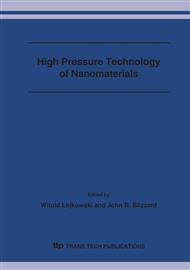p.285
p.291
p.297
p.303
p.313
p.321
p.329
p.337
p.345
X-Ray Analysis of High Pressure Torsion Induced Nanostructures in Ti and Ni
Abstract:
X-ray investigations revealed that the increase in the applied pressure during high pressure torsion (HPT) of commercially pure Ti leads not only to substructure refinement with an increase of the dislocation density and microstrain level but also to an α→ ω phase transition at room temperature. The coexistence of both α and ω phases, the latter known as a high pressure phase, in the ratio approximately of 1:3 has been obtained after removal of thehigh pressure. Texture analysis of electodeposited Ni after HPT discovered a new form of crystallite orientation distribution in the nanocrystalline state. A nearly random orientation crystallite distribution has been observed unlike the “traditional” case of a shear texture forming in cubic symmetry metals. The crystallographic texture data obtained were considered as experimental evidence of the changed plastic deformation mechanisms in nanocrystalline Ni produced by HPT.
Info:
Periodical:
Pages:
329-336
Citation:
Online since:
July 2006
Authors:
Price:
Сopyright:
© 2006 Trans Tech Publications Ltd. All Rights Reserved
Share:
Citation:


